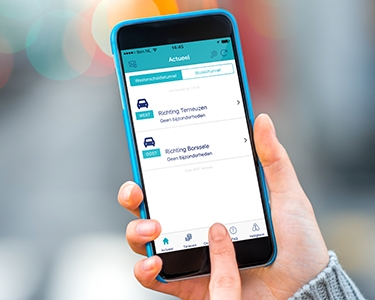Congestion policy
The Westerscheldetunnel can in principle be used 24 hours per day and seven days per week.However, it sometimes needs to be temporarily closed. Maintenance is performed during the night every four weeks.When this happens, all traffic passes through only one tunnel tube so that work can be done in the other tube.Unfortunately, unexpected congestion is also caused by breakdowns, technical failures and collisions.The tunnel tube may be temporarily closed for the safety of tunnel users, emergency services and our employees.
Why does the tunnel tube have to be closed to salvage a broken down vehicle?
This is for the safety of both the driver and the person who will salvage the vehicle. The N.V. Westerscheldetunnel is obliged to guarantee the safety of tunnel users, emergency services and its own employees. This can only be assured by temporarily closing the entire tunnel tube.
Broken down cars are rescued immediately, both during and outside of peak hours. This means that the tunnel tube will be closed for up to half an hour. Trucks are always rescued outside of peak hours. In that case, the tunnel tube is closed for a total of up to an hour.
Why is oncoming traffic not allowed when there is an accident in the tunnel?
Oncoming traffic (traffic in both directions through one tunnel tube) in the Westerscheldetunnel is not permitted by law. An exception is made for maintenance during off-peak hours (between 9 p.m. and 5 a.m.).
Safety is the foremost reason for not allowing oncoming traffic. In the event of a fire or when smoke is created, the ventilation is activated in the same direction as the traffic. Motorists who are ahead of the incident just drive through the tunnel without being inconvenienced by the smoke. The traffic behind the accident cannot move, but at least experiences clean air due to the activation of the ventilation. When there is oncoming traffic, this option cannot be offered in one of the two directions. That is why oncoming traffic is not allowed in the Westerscheldetunnel.
Why are traffic breaks not put in place when there are prolonged obstructions?
N.V. Westerscheldetunnel carried out a study in 2012 into the use of ‘traffic breaks’ to avoid or solve tailbacks in the event of prolonged obstructions. A traffic break means that traffic flow alternates through the same tunnel tube that is available. Traffic is first allowed to pass through the tunnel in one direction for a set period and then allowed to pass through for a set period in the other direction. This means that traffic in both directions has a chance to pass through the tunnel, though only for a certain period of time.
Due to the length of the Westerscheldetunnel (6.6 kilometres), it takes a relatively long time to allow all of the traffic to flow through one tunnel tube and to start traffic flowing from the other direction. In theory, doing this would create at least 1 hour of traffic from the direction of Terneuzen and 1 hour of traffic from the direction of Borsele. Only this way can a considerable part of the waiting vehicles be allowed to pass through the tunnel. However, this creates problems in Zeelandic Flanders because it disrupts the traffic flow in Terneuzen, particularly at rush hour. This means that if we close one tunnel tube for longer periods (over 1.5 hours), then the only option is to divert traffic via Antwerp.
The diversions from the normal route to Antwerp are indicated with U boards (U09 and U21). Furthermore, we use Twitter and the WSTVerkeer app, email and SMS to keep road users informed and updated. Do you want to stay up to date too? Read more here.

